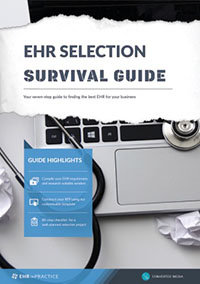4 steps to successful EHR training
In order to ensure user buy-in for a successful EHR implementation, it is essential to provide thorough EHR training so that users feel comfortable and confident in the new system. Poor training can lead to frustrated users and poor clinician buy-in. Utilize these four steps to increase the confidence of your EHR implementation.
1) Appoint one or two super-users
Determine which clinical staff members have some prior experience with EHR systems or are IT savvy and also willing to provide extra guidance and mentoring to fellow employees. Designate these EHR super-users to be the “go-to” people when questions arise. These individuals should receive in depth training on all facets of the EHR system, so that they can readily understand and answer questions from various staff, both clinical and office related. It may be beneficial to incentivize this position with an extra vacation day or a small bonus.
2) Train employees in the specific component they will be using
It is unreasonable and unproductive to train every employee in every facet of the EHR system. By trying to train employees in every facet of the EHR system, you will likely create confusion and slow down mastery of the system. Instead, train clinical staff in the clinical components of the system that they will be using. Train office staff in the administrative and operational components of the system. If office staff will not be conducting evaluations, then there is no need for them to know how to input clinical data.
Recommended Reading: EHR Selection Survival Guide - Select the right EHR for your practice
3) Provide customer support contact information as well as training to utilize online training material
The true experts of the EHR system, are the customer support personnel themselves. As part of your onboarding process, you should be entitled to member support via online or telephone communication. In addition, many EHR vendors offer online community resources in the form of webinars, flow charts, and online training manuals. These online resources are typically available when you log-in to the EHR system. Be sure that your practice staff is aware of these resources, so they may find answers independently, which should reduce frustration and productivity issues.
4) Welcome feedback, suggestions, and concerns
Training will not end with implementation of your EHR system. Once your staff begin to use the system with real patients and with day to day operations, they will inevitably experience some difficulties and problems. The best way to identify problems and quickly resolve issues, is to ask staff for regular feedback. This way, you can identify common areas of confusion and readily retrain all staff. You can host weekly EHR meetings with all different members of the practice (nurses, physicians, billing, front office etc), so that all issues can be brought forth. Once issues are identified, you can more easily find solutions.
Free white paper

EHR Selection Survival Guide
The comprehensive guide to selecting the best EHR system for your medical practice.

Featured white papers
-

EHR Implementation Template
Get all the planning tools you need to make your EHR implementation a success
Download -

EHR implementation: 6 steps to success
Step-by-step information on how to implement EHR effectively
Download -

EHR Vendor Directory
Get the most up-to-date directory of EHR software vendors. Find the best software for your practice.
Download
Related articles
-

EHR Implementation Plan: Your 8-Step Checklist
Your comprehensive checklist for creating an EHR implementation plan.
-

A template for your EHR project implementation timeline
Determining your EHR project timeline will prove tricky, but having some expectations of time fra...
-

5 important areas of EHR training during implementation
Successful EHR implementation is not possible without crucial EHR training

